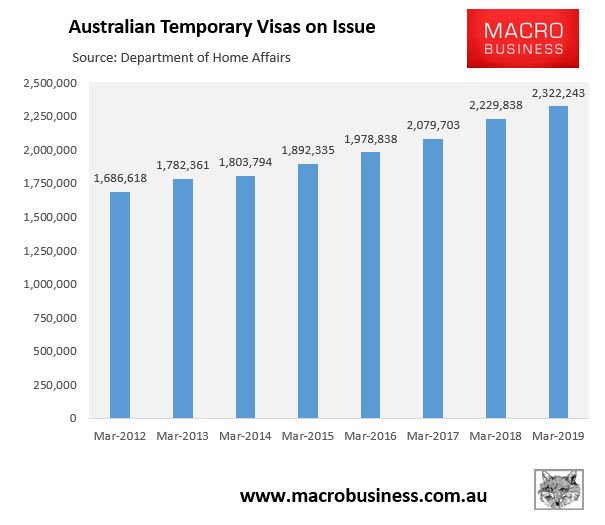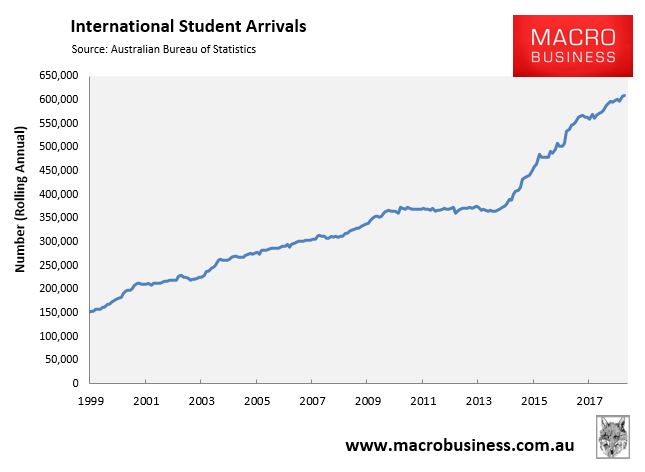The Department of Home Affairs temporary visa statistics for the March quarter of 2019 have been released with the total number of temporary visas on issue ballooning past 2.3 million:

As shown above, this was the highest number of temporary visas on issue for a March quarter on record, with total visas up 92,400 on March 2018 and 635,600 higher than March 2012.
The next table shows the changes by temporary visa category:

As you can see, international students (+268,000) are by far the largest driver of the surge in temporary migrants since 2012. There has also been big rises in visitor visas (+128,500) and bridging visas (+96,000) over the same period.
As noted yesterday, the Australian Bureau of Statistics’ short-term arrivals data shows a similarly large rise in student visas, from 367,000 in March 2012 to 610,000 as at March 2019:

This surge in student visas represents further bad news for Australian wage growth. International students have been at the pointy end of the systemic exploitation of migrant workers and wage theft across the Australian economy, as noted by the Australian Council of Trade Unions:
The relatively recent availability of a large and vulnerable pool of temporary migrant workers has undoubtedly contributed to current record low levels of wages growth and a growing reluctance by employers to train local workers…While there are approximately 1.5 million temporary entrants with work rights, the overseas worker team at the Fair Work Ombudsman consists of only 17 full time inspectors to investigate cases of exploitation – over 80,000 visa workers per inspector. Inadequate enforcement and penalties act as an incentive for employers to exploit temporary workers when the benefit from doing so outweighs the cost of the penalty. or where the probability of being caught is sufficiently low….There have been a range of abuses uncovered which have clearly shown that the entire system is broken. From 7-11 and Domino’s to agriculture, construction, food processing to Coles, Dominos and Caltex, it is clear that the abuses occur in a number of visa classes whether they be students, working holiday makers or visa workers in skilled occupations.
Official stock data indicate that the visa programmes for international students, temporary skilled workers and working holiday makers have tripled in numbers since the late 1990s…
Decisions by the federal Coalition government under John Howard to introduce easier pathways to permanent residency for temporary visa holders, especially international students and temporary skilled workers, gave a major impetus to TMW [temporary migrant worker] visa programmes.
Most international students and temporary skilled workers, together with many working holiday makers, see themselves as involved in a project of ‘staggered’ or ‘multi-step’ migration, whereby they hope to leap from their present status into a more long-term visa status, ideally permanent residency…
Though standard accounts describe Australian immigration as oriented to skilled labour, this characterisation stands at odds with the abundant evidence on expanding temporary migration and the character of TMW jobs… the fact that their work is primarily in lower-skilled jobs suggests that it is more accurate, as several scholars point out, to speak of a shift in Australia towards a de facto low-skilled migration programme…
Research shows that in industries where employers have turned to temporary migrants en masse, it erodes wages and conditions in these industries over time, making them less attractive to locals…
Alongside eroding tertiary education standards and crush-loading the major cities, Australia’s international student boom is also flooding Australia’s labour market with cheap exploitative labour.
It’s time the international student trade was subjected to public review by the Productivity Commission to ascertain the true costs and benefits of the system.

